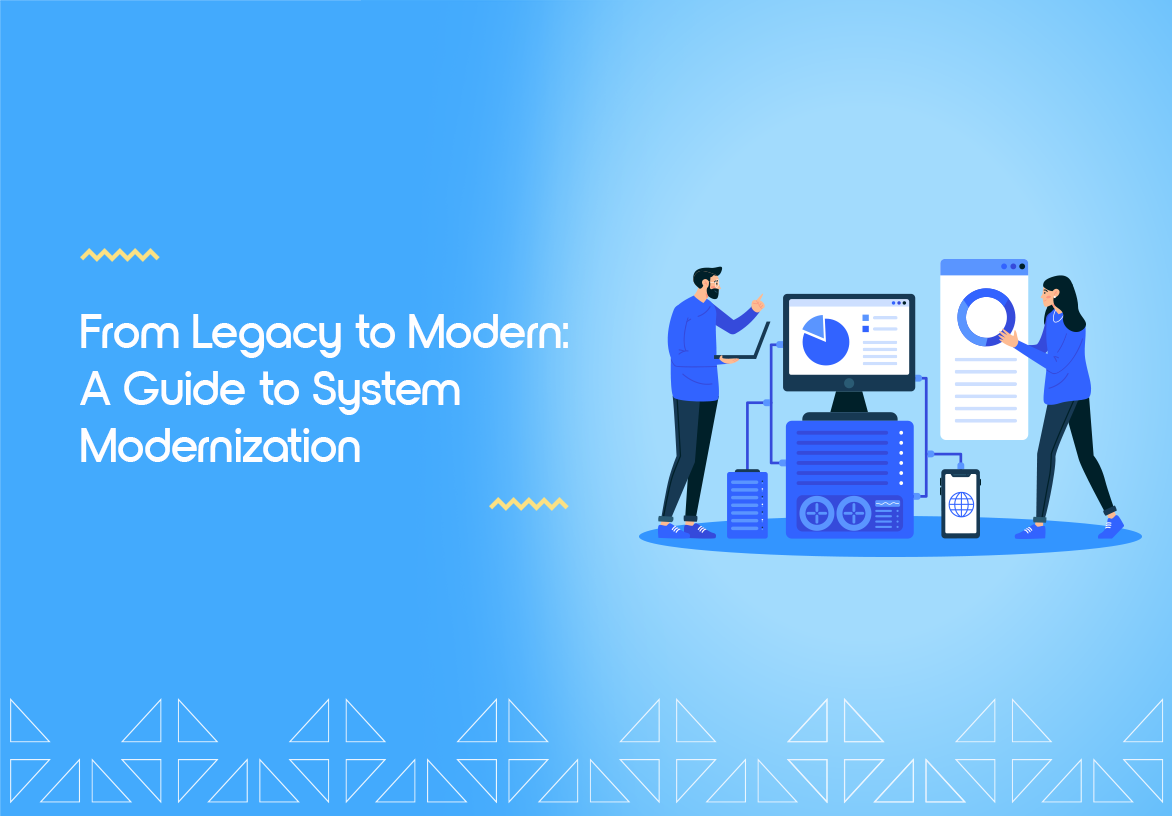From Legacy to Modern: A Guide to System Modernization
Businesses struggle with legacy applications that no longer meet their needs. In this article we talk about how our expertise can make it easier.
From Legacy to Modern: A Guide to System Modernization
Businesses often struggle with legacy applications that no longer meet their current needs. The challenges that come with outdated software can be daunting, ranging from incompatibility issues to the cost and effort required for a complete overhaul. In this blog, we’ll explore the nuances of legacy applications, dive into the low-code modernization process, and highlight potential challenges while showing how Zcoderz’s expertise can make the journey smoother.
Types of Legacy
Legacy applications can be broadly categorized based on two key factors – provenance and maintenance status. Internally developed applications and external applications from third-party vendors present different challenges. It is also crucial to distinguish between applications that are no longer supported and those that have fallen into disrepair due to lack of maintenance. Internal applications may require a more tailored modernization approach, while external applications may require negotiations with vendors or a move to a more flexible solution.
However, the crucial factor to consider an application as legacy is the user's assessment. When there is a mismatch between the requirements of your business and the features that an application offers, a company can make the decision to consider an application as legacy.
Applications can be considered legacy based on several factors, such as internal knowledge around the application and/or technology stack used for the application. Or an application no longer meets security and compliance requirements. Or the needs and requirements of the business that shift and/or expand.
Legacy modernization is all about security considerations and compliance. Meeting today’s security standards and regulatory requirements is critical. At zcoderz, we guide companies through the complex process of modernization, ensuring not only improved functionality, but also enhanced security measures and adherence to evolving compliance standards.
Modernizing with low-code
Modernizing legacy applications with low-code is a multi-phase process that requires careful consideration at every step. By breaking the journey down into different phases, we can better understand the intricacies of low-code modernization.
Analysis
The journey begins with a thorough analysis of the existing legacy application. This phase identifies key business requirements, assesses the application architecture, and understands user workflows.
A notable advantage of low-code platforms during the analysis phase is their visual nature. Low-code environments often have intuitive drag-and-drop interfaces, making it easier for stakeholders, including non-technical users, to participate in the process. Visual representations of workflows and data models provide clear communication, ensuring that all aspects of the legacy application are accurately captured
However, there are additional complexities to modernizing with low-code. Unlike traditional high-code approaches, which often focus on a single application, low-code platforms really thrive when used as a comprehensive solution across multiple applications. The challenge is identifying a platform that not only fits the current legacy application, but also aligns with the organization’s broader modernization strategy.
The plethora of available low-code platforms complicates the analysis phase. Each platform has its own strengths, limitations, and suitability for specific use cases. Choosing the right fit requires a thorough evaluation of each platform’s capabilities versus the unique requirements of the legacy application. Our guidance and knowledge base of over 170 platforms is an indispensable tool in helping companies make the right choice.
Development and integration
Once the analysis is complete, the chosen low-code platform comes into action. Low-code development involves visually building application components, automating business processes, and integrating with existing systems. At this stage, the speed of low-code development becomes a key advantage, allowing stakeholders to track the development of the application in real time.
The visual nature of low-code makes it easier to develop and refine the application iteratively. Business logic is often expressed graphically, which reduces the need for extensive coding. Integration with external systems is streamlined by pre-built connectors, which speeds up the development process. This flexibility is a significant advantage, especially when compared to traditional development methods.
Deployment and scalability
Once development is complete, the modernized application is ready for deployment. Low-code platforms often offer simplified deployment processes, with options for cloud hosting and scalability. This phase marks the transition from development to live production, with zcoderz’s expertise ensuring a smooth deployment process.
Scalability is a notable advantage of low-code platforms. As business needs change, the application can easily scale to accommodate new features and increased user load
Maintenance and updates
The journey doesn’t end with deployment. Continuous maintenance and updates are crucial to keep the modernized application in line with changing business needs. Low-code platforms simplify maintenance through their visual, modular structure. Changes can be implemented with minimal disruption and updates can be rolled out efficiently.
However, it is essential to approach maintenance strategically to avoid pitfalls that can turn the once modernized application back into a legacy burden. Zcoderz's ongoing support ensures that companies navigate this phase effectively and make informed decisions about updates and extensions.
The low-code platform as legacy
Over time, the low-code platform itself can become legacy. Advances in technology and shifts in business requirements can necessitate a move to newer platforms. Zcoderz's role extends beyond the initial modernization and guides companies in evaluating the longevity of their chosen low-code solution.
The visual and modular nature of low-code platforms, when used effectively, makes transitions smoother. Our knowledge base helps with strategic planning of migrations and ensures that the low-code platform does not become a hindrance, but rather paves the way for future innovations.
To Wrap Things Up
Modernizing legacy applications with low-code is a powerful option when approached with care and expertise. By understanding the types of legacy applications, embracing the right low-code platform, and avoiding common pitfalls, businesses can begin a successful journey toward a more agile, future-ready IT landscape.

